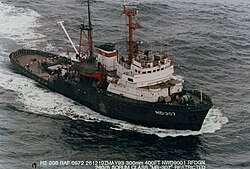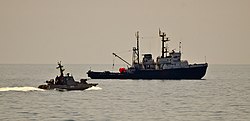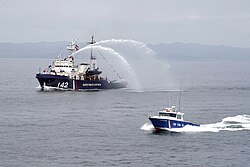 The Russian Navy Sorum-class seagoing tug MB-99 (Project 745) during the Navy Day celebrations at Vladivostok in 2008 | |
| Class overview | |
|---|---|
| Name | Sorum class |
| Builders |
|
| Operators |
|
| In commission | 1972 |
| Completed | c. 43 [1] |
| General characteristics (Project 745) | |
| Type | Seagoing tug |
| Displacement | 1,452 t (1,429 long tons; 1,601 short tons) |
| Length | 56.5 m (185 ft 4 in) |
| Beam | 12.64 m (41 ft 6 in) |
| Draft | 4.47 m (14 ft 8 in) |
| Installed power |
|
| Propulsion |
|
| Speed | Max: 13.2 knots (24.4 km/h; 15.2 mph) |
| Range | 6,200 nmi (11,500 km; 7,100 mi) at 13 kn (24 km/h; 15 mph) |
| Endurance | 40 days |
| Complement | 35 |
| Sensors & processing systems | |
| Armament | |
The Sorum class, Soviet designation Project 745, is a series of seagoing tugs built for the Soviet Navy and KGB Border Troops, and later operated by the Russian Navy and FSB Border Service. [3]
Contents
These vessels perform the standard missions of a seagoing tugboat with other missions such as protecting and patrolling Russian maritime borders, enforcing navigational rules and law enforcement, search and rescue, and fisheries protection.






